woelen
Super Administrator
        
Posts: 7976
Registered: 20-8-2005
Location: Netherlands
Member Is Offline
Mood: interested
|
|
Storage stability of 98+% formic acid?
I have 250 ml of formic acid (HCOOH) in a glass bottle, with a tight screw cap. The acid concentration, according to the label of the original bottle
is between 98% and 100%. The remain 1% to 2% is water.
I was reading about this acid and its properties, but at some websites I read about slow decomposition of the acid into water and carbon monoxide. The
latter would be a big safety risk, because it would lead to pressure buildup in the bottle and might lead to explosion, due to high pressure.
Normally, formic acid is sold at 85% concentration where I live, and I know from experience that this is perfectly stable on storage. I have a few
hundreds of ml of that 85% acid and never observed buildup of pressure in this bottle, not even after having it stored for a few years without opening
it.
Is 98% acid less stable? How real is the risk of explosion due to pressure buildup of decomposing acid? If indeed there is decomposition at nearly
100% concentration, what concentration is safe (no decomposition anymore)? This must be somewhere above 85%, given my experience with that
concentration.
|
|
|
Bonee
Harmless

Posts: 29
Registered: 20-12-2010
Member Is Offline
Mood: No Mood
|
|
In the past I had kept a few bottle of it (98%) for over 2 years without any problems. they were always under 20c though.
|
|
|
teodor
National Hazard
   
Posts: 872
Registered: 28-6-2019
Location: Heerenveen
Member Is Offline
|
|
We know from the literature that Rhodium, Iridium, Ruthenium, and Platinium catalyze the dissociation of formic acid to CO2 and H2 at room
temperature. I am sure that there are no those impurities on the glass surface of your bottle. But if somebody mentioned decomposition it could be
also an effect of some other impurities.
|
|
|
woelen
Super Administrator
        
Posts: 7976
Registered: 20-8-2005
Location: Netherlands
Member Is Offline
Mood: interested
|
|
I am not that afraid of the metal-catalysed decomposition into CO2 and H2. I certainly do not expect that to occur in my case.
My concern is about the acid-catalysed decomposition into H2O and CO. That decomposition can quite easily occur. E.g. if you add formic acid to
sulfuric acid, then you get slow decomposition. If you heat gently, then you get a gentle and quite constant stream of CO, which can be ignited,
giving a pale blue flame. I have done that experiment a few times. Nice to do as experiment, but not something you want in your stored acid, not even
slowly, because it may lead to rupturing of glass containers. On the other hand, I never read about exploded bottles of formic acid, but I do read
about the need to occasionaly vent your bottle of formic acid to release pressure and another reason I have concerns about this, is that they write
that the acid should be used within five years. Is this, because the concentration lowers over time? On 85% bottles I do not see such warnings, so
apparently, this issue only exists at really high concentrations. Safety documents also distinguish between 90+ concentrations and 90- concentrations.
|
|
|
teodor
National Hazard
   
Posts: 872
Registered: 28-6-2019
Location: Heerenveen
Member Is Offline
|
|
It says "5 years after opening the bottle".
|
|
|
teodor
National Hazard
   
Posts: 872
Registered: 28-6-2019
Location: Heerenveen
Member Is Offline
|
|
Yes, it slowly decomposes, according to this book "care must be taken in opening formic acid containers":
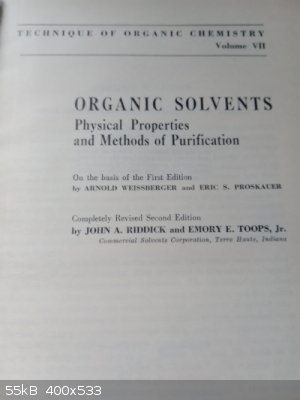 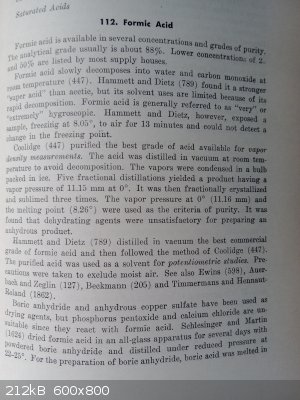 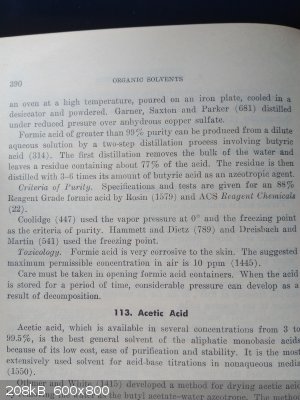
|
|
|
teodor
National Hazard
   
Posts: 872
Registered: 28-6-2019
Location: Heerenveen
Member Is Offline
|
|
I think HCOOH is not the only chemical that requires a regular inspection.
Look what happens with the cap of my chlorosulfonic acid.
I discovered it only today. I hope it was not decomposed too much thanks to the protective container & absorbent.
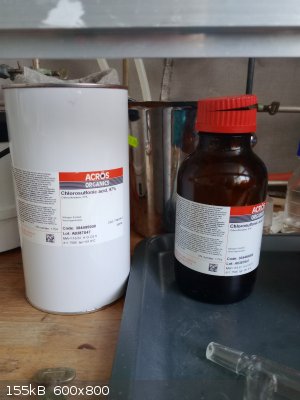
|
|
|
woelen
Super Administrator
        
Posts: 7976
Registered: 20-8-2005
Location: Netherlands
Member Is Offline
Mood: interested
|
|
That's really bad 
I have had similar issues with storage of my PCl5 and SO2Cl2. Some chemicals are so extremely corrosive that they hardly can be stored in normal
bottles for more than a few months, not even with very good caps like the one, shown in the picture (which is a high quality cap with teflon liner and
high temperature PP).
I ampouled my following chemicals:
PCl3
PBr3
PCl5
SO2Cl2
SOCl2
NbCl5
CH3COCl
(COCl)2
I only have small working bottles for experiments with these chemicals, main stock is in ampoules. Some of these working bottles are in awful
condition, especially the one with PCl5. That one has a completely "rotten" cap, which is a $10 red GL32 cap with teflon liner. But even that is
blistered and eaten away and brown goo is running slowly into the bottle.
Remarkably, I also have oleum, stored already for several years, and the cap of the bottle of that looks very good. Apparently the halogen in the
other highly corrosive chemicals slowly eats the caps. My bottle of bromine, however, stores quite well. Some brown coloration inside the cap, but
structurally it still is perfectly fine after a few years.
[Edited on 30-6-22 by woelen]
|
|
|
Isberg
Harmless

Posts: 1
Registered: 1-5-2007
Location: Sweden
Member Is Offline
Mood: No Mood
|
|
@woelen
The last bottle of concentrated formic acid came with a special pressure relief cap. I have several bottles of the stuff and recently noticed that a
plastic one from Shaurlau builds pressure so I take care to ventilate it often. I keep these in the chem fridge.
I also noticed that red fuming nitric acid can build pressure over time. H2O2 as well.
I have similar bad experiences with the red expensive GL45 caps with various chemicals.
My bottle of bromine came with a yellow gl32 cap that stod up well over the years.
@teodor Exactly the same happened to my Acros bottle of chlorosulfonic acid, it was a few years old and opened. Mine was not ok afterwards. Yours
looks exactly like the one I disposed of but nicer, same outer can. Big mess.
|
|
|
teodor
National Hazard
   
Posts: 872
Registered: 28-6-2019
Location: Heerenveen
Member Is Offline
|
|
Today while reading the book "Chemie in niederen Fettsauren und ihren Derivaten" I found excellent instruction of handling anhydrows HCOOH:
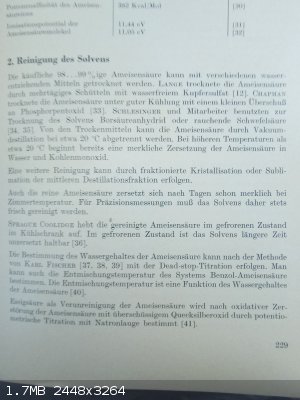
I know, woelen, you can read it but for rest of us the automatic translation exists:
Commercially available 98...99% formic acid can be dried with various dehydrating agents. LANGE dried the formic acid by shaking it with anhydrous
copper sulfate for several days [12]. CHAPMAN dried the formic acid under good cooling with a small excess of phosphorus pentoxide [33]. SCHLESINGER
and co-workers used boric anhydride or fuming sulfuric acid to dry the solvent (34, 35). The formic acid can be separated from the desiccants by
vacuum distillation at about 20 °C. At temperatures higher than about 20° C., a noticeable decomposition of the formic acid into water and carbon
monoxide begins.
Further purification can be carried out by fractional crystallization or sublimation of the middle distillation fraction.
Pure formic acid also decomposes noticeably after a few days at room temperature. The solvent must therefore always be freshly
cleaned for precision measurements.
SPRAGUE COOLIDGE keeps the purified formic acid frozen in the refrigerator. When frozen, the solvent can be stored for a long time without
decomposing [ 36 ] .
The water content of the formic acid can be determined according to the method of KARL FISCHER [37, 38, 39] with dead-stop titration. The demixing
temperature of the benzene-formic acid system can also be determined. The demixing temperature is a function of the water content of the formic acid
[40].
|
|
|